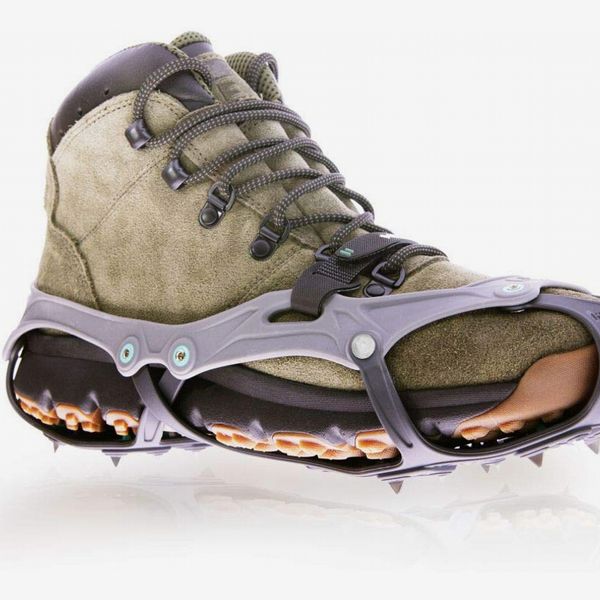
In this article
Whether your morning commute begins with a long trek to the subway or a short walk to your car, icy winter pavement can be hazardous or even deadly. A good pair of traction cleats — typically a rubber shoe harness with steel spikes or studs, and also sometimes known as crampons — can ensure the day doesn’t begin with a wipeout. This shoe accessory can make any pair of boots, sneakers, or even Crocs weather-ready. Traction cleats can make a huge difference for winter hiking where there’s snow and slippery, frozen-over sections on the trail.
I’ve been testing and reviewing outdoor gear for publications since 2018, and like most of what I’ve learned about being outside, I learned the importance of ice cleats the hard way. The first time I knew I needed winter traction was at Great Smoky Mountains National Park on a college spring-break trip. Half of the trails were muddy from rain, and the other half were coated with a layer of ice, like a sheet of cake frosting. My friend and I tried the first couple hundred meters of our backpacking route, but slipped and fell our way down the mountain and retreated to our car. We stopped at a gear shop to get some dry socks, and when we told the store employee about the trail conditions, they recommended we get some cleats for the icy sections of trail, which worked like a charm. Now I never go winter hiking without a pair of spikes in my pack.
Having winter traction is just as much about safety as it is about peace of mind, especially on trails on public lands and state parks. Matt Way, a store manager at Rock and Snow in New Paltz, New York, says that the shop sells hundreds of pairs of cleats in the winter. “Some local spots, like in the Mohonk Preserve, or the Minnewaska State Park Preserve, will sometimes require visitors to have winter traction to let you go hiking at all. Some folks get turned away at the gate.” Way tells me that hikers have come into the shop looking for ice cleats because of this reason.
I talked to experts like Way from local outdoor-gear shops for their go-to traction-cleat recommendations, and I also scoured our hiking and winter-running archives to get the best picks from Strategist staffers and contributors.
What we’re looking for
Traction type
There are two main types of traction you’ll find on most pairs of cleats: coils and spikes (which, for the purposes of this article, will include studs and beads). Some models have a series of metal coils wrapped around the bottom of the rubber cage (the top of which wraps around your shoe or boot). Way says that coil-style models are really designed for packed snow and not actual ice. “Coils have a tendency to break when you get onto hard ice,” he says. “But if you’re walking the dog on a packed snow trail, models with the coil traction will be great.” Other traction devices that have spikes, studs, or beads on the bottom are better for icier surfaces, because they can dig into the ice more deeply. For those models, the spikes can come in varying shapes and lengths.
Attachment type
Most of these models have a rubber cage that stretches around the heel, toe, and sides of a boot or shoe. Some models have a plastic plate with spikes or coils attached to the rubber cage, while other models will have a series of metal chains attached to the cage. Devices with chains are generally heavier than those with just rubber underfoot. By nature of their construction, rubber attachments are more prone to snapping and tearing than metal chains, but in years of testing different rubber models on hikes, runs, and walks around town, I haven’t encountered any models that broke on me. Way says that no matter the attachment style, make sure they’re snugly wrapped around your foot. “You don’t want the chains underneath to be loose, and you want to make sure the rubber’s robust on it.” Some devices have a Velcro strap or reinforcement that goes over the top of the foot, across the laces of your shoe or boot.
Length of spikes
Longer spikes are meant for steeper, icier terrain, while shorter studs or coils are meant for more casual walking and running. The longer the spikes, the more awkward it might feel walking on hard (non-icy) surfaces, like pavement. The lengths of all the spikes below are all under one inch, so I’ve categorized them as short (less than 3/8 of an inch), medium (3/8 inch to 1/4 inch), and long (2/3 inch and longer).
Best for everyday chores
Traction type: Steel beads | Attachment type: Rubber cage attached to beads on steel cable | Length of spikes/studs: Short
Yaktrax has become a household name in the winter traction world, and the Diamond Grip is one of the brand’s most popular models. The steel beads housed on a steel cable system underfoot are particularly effective, because the beads can rotate and sink into the surface at any angle. I used the Diamond Grip to stay upright when I lived in Boston and had to walk on icy sidewalks on my morning commute. Given the smaller beads on these cleats, the Diamond Grips wouldn’t be my first choice for hiking (that would be the Hillsound FlexSteps, below), but for easy winter day hikes, I could imagine the Diamond Grip will do just fine.
Best less-expensive for everyday chores
Traction type: Steel coil | Attachment type: Rubber cage | Length of spikes/studs: Short
When my friend and I retreated into that gear shop outside of Great Smoky Mountains National Park after slipping on icy trails, these were the cleats I bought. Looking back, I would have gone with a more aggressively spiked model, per Way’s advice, but these cleats with coils kept me sure-footed on the ice when we returned to those trails. After a few years of use, though, I have noticed that the coils have become bent and flattened out, so I would reiterate Way’s advice and recommend using these solely on packed snow or doing winter chores.
Best for moderate hiking
Traction type: Steel spikes | Attachment type: Rubber cage with riveted attachment points and reinforcement strap | Length of spikes/studs: Medium
I like the FlexSteps for moderate hiking because they have medium-length spikes and rivets on the rubber cage, plus a Velcro strap, which means the entire system stays put as you go over different terrain. The FlexSteps excelled on a 2019 trip to Iceland, where some sections of the hike were entirely ice. They also come recommended by Strategist contributor Steven John, who straps them onto his sneakers or snow boots when he’s doing winter chores like taking the trash out or shoveling snow. “They’re easy to get on and off, the spikes are sharp enough to dig into ice but small enough not to make it hard to walk on exposed concrete,” John says.
Most durable cleats for winter hiking
Traction type: Steel spikes | Attachment type: Rubber cage with steel chains | Length of spikes/studs: Medium
The Kahtoola Microspikes come recommended by Mary Noack, a staff member at the Mountaineer in Keene Valley, New York. Noack says they frequently recommend the Kahtoolas to customers for hiking on icy trails in the Adirondack Mountains. In our roundup of the best women’s hiking boots, Strategist writers Katherine Gillespie and Liza Corsillo spoke to Melissa Goodwin, licensed outdoor guide and the founder of Girl Gotta Hike NYC, who recommended pairing the Microspikes with boots if you’ll be hiking in the winter and called them a “tried-and-true” device for boosting traction.
Best for hikes on icy trails
Traction type: Carbon steel spikes | Attachment type: Rubber cage with steel chains and reinforcement strap | Length of spikes/studs: Long
Noack says the Trail Crampons are a favorite amongst staffers and customers at the Mountaineer, and recommends them for steep hikes on icy trails. “They are just a little bit more aggressive [than the Kahtoolas], so on a lot of terrain around here, when you get onto open exposed ledges that are covered in ice, you can feel a little bit more secure, and you can really stamp them into the ice and get firm traction.” Noack says that the Velco reinforcement strap is “another backup to make sure that you’re not gonna slip out of ’em.”
Best for long hikes
Traction type: Carbon steel spikes | Attachment type: Rubber cage with steel chains and reinforcement strap | Length of spikes/studs: Long
The Ultra is very similar to the Trail Crampon, but the Ultra is lighter weight and has slightly shorter spikes. That makes the Ultra a great option for longer hikes where you’ll be able to feel that small amount of weight difference over time. Way says that the Ultra is a best seller at Rock and Snow.
Best for running on pavement
Traction type: Tungsten carbide studs | Attachment type: Rubber cage with plate underfoot | Length of spikes/studs: Short
The small studs on this low-profile traction device make it great for running on mixed-condition roads in the winter. I like using the NANOspikes to run when it’s snowy. Sometimes it’s unclear whether there’s black ice or glazed-over patches of pavement beneath the snow, and running with these on gives me that extra bit of stickiness on each stride.
Best for running on mixed terrain
Traction type: Steel coils and studs | Attachment type: Rubber cage with reinforcement strap | Length of spikes/studs: Short
Former Strategist senior writer and avid runner Karen Iorio Adelson swears by these cleats, which feature two types of traction: coils in the heel and studs underneath the forefoot. That combo helps provide traction on surfaces like packed snow and slippy surfaces. Adelson calls them “a must-have if you’re dedicated to running in all conditions.”
Our experts
• Liza Corsillo, Strategist senior writer
• Katherine Gillespie, Strategist writer
• Melissa Goodwin, licensed outdoor guide and the founder of Girl Gotta Hike NYC
• Karen Iorio Adelson, former Strategist senior writer
• Steven John, Strategist contributor
• Mary Noack, staff member at the Mountaineer in Keene Valley, New York
• Matt Way, store manager at Rock and Snow in New Paltz, New York
The Strategist is designed to surface the most useful, expert recommendations for things to buy across the vast e-commerce landscape. Some of our latest conquests include the best acne treatments, rolling luggage, pillows for side sleepers, natural anxiety remedies, and bath towels. We update links when possible, but note that deals can expire and all prices are subject to change.
Every editorial product is independently selected. If you buy something through our links, New York may earn an affiliate commission.















